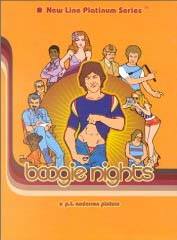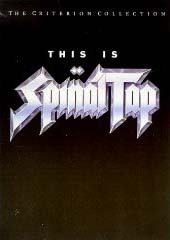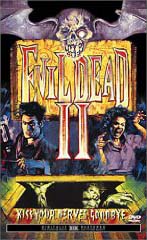“Hey, roll it, ’cause I’ll tell ya, you know, you’re listening to a guy who learned a lot about ripping off movies from watching laserdiscs with director commentary.” Á¢€”Paul Thomas Anderson, from the Boogie Nights audio commentary
Okay, so I’m an audio commentary junkie. Sometimes I’ll buy a movie I don’t particularly like all that much just because it has a commentary track or other cool extras. It seems like I’m always repurchasing some movie I already own simply because the new version has extra features.
In the laserdisc days there was Criterion. The very first audio commentary track was done by film historian Ronald Haver on the 1984 Criterion laserdisc of King Kong (1933). Unfortunately, many of those Criterion tracks still haven’t made it to DVD, including Martin Scorsese’s commentaries for Raging Bull and Taxi Driver, and Terry Gilliam’s for The Fisher King (all worth checking out, provided you can find a working laserdisc player).
 Boogie Nights (1997; director Paul Thomas Anderson). This is pretty much everything I look for in a commentary track, so it’s really too bad Anderson doesn’t seem to want to record them anymore (to date, this is the last one he’s done). There’s a lot of cool information here, including many anecdotes about the production of the film, but the real fun for me is hearing Anderson talk excitedly about how much he loves to write material for certain actors.
Boogie Nights (1997; director Paul Thomas Anderson). This is pretty much everything I look for in a commentary track, so it’s really too bad Anderson doesn’t seem to want to record them anymore (to date, this is the last one he’s done). There’s a lot of cool information here, including many anecdotes about the production of the film, but the real fun for me is hearing Anderson talk excitedly about how much he loves to write material for certain actors.
ANDERSON (on actor William H. Macy): And you know, everything you write, you better know what you’ve written, because he is going to say every single word exactly as you’ve written it. And he’ll sort of look at the punctuation, find out what it means. A dash means this, an ellipses means that. You know, this is in quotes, this has been underlined, this has been italicized … He’s all about finding out what the writer means, you know, and he studies the script clearly so well that as a director you don’t really have to do shit. You just have to watch him, because I feel like I did my job as a writer, so being a director was just being a fan.
El Mariachi (1992; director Robert Rodriguez). I’m actually not the biggest fan of this movie, or Rodriguez’s films in general, but I own several of his DVDs simply because his commentary tracks are so terrific. His book about El Mariachi, Rebel Without a Crew (1996), is one of the best “making of” film books I’ve ever read. On this particular audio track, he goes into great detail about his filmmaking process, and in the case of El Mariachi it’s particularly interesting to learn how he got it made on such a microscopic budget (roughly $7,500).
RODRIGUEZ: Everyone has their own style of working, but there’s a lot of directors who will shoot and shoot and shoot and have the editor figure out what the movie is later on. But if you don’t have any money, you don’t have that luxury. You really have to know what your movie is before you go out and shoot it, and shoot only the shots that you really need. We were able to grab this movie — this whole sequence, especially — very quickly because I knew I only needed one take of him coming through the door, because that’s all I was going to show. And I knew I only needed one take of this because it was going to be in close-up. I don’t have another take of a master shot or anything. I cut it in my head first and scripted it very carefully and then shot only what I knew I was going to use as an editor in the final film.
 Fast Times at Ridgemont High (1982; director Amy Heckerling, writer Cameron Crowe). When Heckerling and Crowe get going, it’s like listening to two old friends shoot the shit. In fact they seem to enjoy it so much, they continue yakking a good eight minutes after the credits have faded out. The end result is a fascinating discussion about how difficult it is to get the rights to Led Zeppelin songs and how Heckerling was forced by Universal Pictures to use some songs she outright hated. Also, at one point, she says, the studio was so concerned she wasn’t making a comedy that they had John Landis visit the set to check up on her. (By the way, Crowe’s commentary for the Say Anything DVD is also worth checking out.)
Fast Times at Ridgemont High (1982; director Amy Heckerling, writer Cameron Crowe). When Heckerling and Crowe get going, it’s like listening to two old friends shoot the shit. In fact they seem to enjoy it so much, they continue yakking a good eight minutes after the credits have faded out. The end result is a fascinating discussion about how difficult it is to get the rights to Led Zeppelin songs and how Heckerling was forced by Universal Pictures to use some songs she outright hated. Also, at one point, she says, the studio was so concerned she wasn’t making a comedy that they had John Landis visit the set to check up on her. (By the way, Crowe’s commentary for the Say Anything DVD is also worth checking out.)
CROWE: We never called him Sean. It was weird that we had this actor named Sean Penn, but to us he was Jeff Spicoli. And I remember, after he had finished the movie he came onto the set … and he went around to a bunch of us and introduced himself and said “Hi, I’m Sean” … and we said, you know, “Where’s the surfer?” And he said, “Up on the screen — that’s where he lives.”
HECKERLING: People would say to me, “What was it like working with Sean Penn?” and I’d go, “I don’t know. I worked with Jeff.” People tell you Sean Penn stories and you go, “Well, I don’t know that Sean Penn. I know this one we just saw with the long hair and that smile.”
Battle Beyond the Stars (1980; producer Roger Corman, writer John Sayles). Another really fun gathering of two old friends shooting the breeze. Corman has a steel-trap memory of details from throughout his long career, and I’ve always found it interesting to hear him talk about filmmaking. Listening to Sayles and him discuss the practicality of getting movies made and the business in general is a delight.
SAYLES: Joe Dante on The Howling, at one point I was doing a rewrite of what I’d written before, and he said, “Well, you know, if we pad this little part here, I think we can get Slim Pickens” … and I padded it, but I wrote it in this kind of “Slim Pickenese.” And they got Slim Pickens, and he showed up on the set and said, “Boys, this dialogue fits me like a glove.”
CORMAN: I said, “Jimmy [Murakami, the film’s director], I’ll show you what it is, it’s very simple, just see what I’m doing.” And I ran down the hall, jumped up against the walls, spun around, jumped off, and ran in the opposite direction. I said, “It’s just that.” At which point the assistant director said, “Okay, here’s the stuntman.” And I said, “Stuntman? I’m 50 years old. I just did the stunt! Richard [Thomas, the film’s star] is in his 20s. What do we need a stuntman for?”
 This Is Spinal Tap (1984; director Rob Reiner, producer Karen Murphy, editors Robert Leighton and Kent Beyda). I think I learned more about film editing from Reiner’s comments on the Criterion edition of This Is Spinal Tap than any other commentary track out there, e.g. “If you really want to get into filmmaking, what makes a jarring and bad edit is always audio. It’s very rarely picture.” The Criterion DVD also has another cool audio track with stars Christopher Guest, Michael McKean, and Harry Shearer. Of course, the newer “Special Edition” DVD from MGM features a fun commentary track with Guest, McKean, and Shearer all in character as Spinal Tap, but the Criterion recording, now out of print, is still my favorite.
This Is Spinal Tap (1984; director Rob Reiner, producer Karen Murphy, editors Robert Leighton and Kent Beyda). I think I learned more about film editing from Reiner’s comments on the Criterion edition of This Is Spinal Tap than any other commentary track out there, e.g. “If you really want to get into filmmaking, what makes a jarring and bad edit is always audio. It’s very rarely picture.” The Criterion DVD also has another cool audio track with stars Christopher Guest, Michael McKean, and Harry Shearer. Of course, the newer “Special Edition” DVD from MGM features a fun commentary track with Guest, McKean, and Shearer all in character as Spinal Tap, but the Criterion recording, now out of print, is still my favorite.
REINER: We’d shoot it once and then we’d sit and talk a little bit about what we just did and we’d say, “Let’s do it again,” but you know, “Maybe we don’t need to get into that discussion because that’s really irrelevant.” You know, “Let’s lose that discussion” or “Hey, maybe we should add something about this” — you know, some other idea. And then what we would do is then we’d shoot it again. Then we’d shoot it a third time, and every time we shot it, the dialogue would be slightly different, but we’d be generally covering the same subjects. Then I’d shoot it a fourth time, making sure that the cameraman always was on people not talking so that I had plenty of stuff to cut away from if I ever wanted to bridge any of the dialogue. And then when we assembled the film, what we did was really assemble it via the audio track more than what you saw visually. Once we had a good audio track that tracked, that made sense, [where] one bit of dialogue went into the next — you know, conversations that had a flow to them — the picture would go along with those.
Titanic (1997; director James Cameron). The “Special Edition” DVD has two other complete commentary tracks, but what I find interesting about the Cameron one is that he offers more historical background than the track with the actual Titanic historians! It’s a fascinating commentary for anyone interested in which parts of the movie are based on fact and which use artistic license, plus he goes into tremendous detail regarding the film’s many special-effects shots.
CAMERON (on the film’s ending): Now, of course the big ambiguity here is, you know, is she alive and dreaming, or is she dead and on her way to “Titanic heaven” here? And of course I’ll never tell. I mean, I know what we intended at the time, but that doesn’t mean I have to go blurting it out. I know you bought this expensive special-edition DVD and you’re hoping for the answer, but the answer has to be something you supply personally, individually.
 Evil Dead II (1987; director Sam Raimi, actor Bruce Campbell, cowriter Scott Spiegel, special makeup effects artist Greg Nicotero). Another entertaining track on which our hosts provide lots of behind-the-scenes information while at the same time poking fun at their movie. In particular, there’s a point in the film where our hero, Ash (Campbell), takes a chainsaw to his possessed girlfriend, but the carnage is shown with shadows on the wall. Raimi comments, “This is a funny scene, because it’s as though we had the good taste not to show it.”
Evil Dead II (1987; director Sam Raimi, actor Bruce Campbell, cowriter Scott Spiegel, special makeup effects artist Greg Nicotero). Another entertaining track on which our hosts provide lots of behind-the-scenes information while at the same time poking fun at their movie. In particular, there’s a point in the film where our hero, Ash (Campbell), takes a chainsaw to his possessed girlfriend, but the carnage is shown with shadows on the wall. Raimi comments, “This is a funny scene, because it’s as though we had the good taste not to show it.”
CAMPBELL: I remember watching the dailies and Sam turning to me, going, “That is the worst reverse-motion acting I’ve ever seen!” You’d only hear that from Sam.
Apollo 13 (1995; astronaut Jim Lovell and his wife, Marilyn Lovell). The track by Ron Howard is good too, but listening to the Lovells recount their experiences while watching the movie based on those experiences is beyond cool. As it turns out, the movie is incredibly accurate.
JIM LOVELL: This is one of the most critical parts of the flight. The lunar module was completely powered down. We had to transfer the information out of the guidance systems and the computer to the lunar module from the command module before the power died in the command module and we lost all that information … and in those days we didn’t have automatic-transfer systems like we have now. We used a pencil and paper to transfer some of the numbers, as you’ll see.
 Saw (2004; director James Wan, writer Leigh Whannell, and actor Cary Elwes). Elwes does impressions of both Marlon Brando and Michael Caine in this absolutely hilarious commentary. At one point Saw‘s lead actor, writer, and director praise the natural talent of ten-year-old actress Makenzie Vega. Whannell comments, “I actually saw you with her in the corner one day, Cary. And I was like, ‘Isn’t that sweet. Cary, the — you know — the more mature, more experienced actor, is giving Makenzie advice.’ And when I got closer I heard you say, ‘How do you do it? I mean, what is it you’re doing? I’ve got to know. I have a crying scene coming up.'”
Saw (2004; director James Wan, writer Leigh Whannell, and actor Cary Elwes). Elwes does impressions of both Marlon Brando and Michael Caine in this absolutely hilarious commentary. At one point Saw‘s lead actor, writer, and director praise the natural talent of ten-year-old actress Makenzie Vega. Whannell comments, “I actually saw you with her in the corner one day, Cary. And I was like, ‘Isn’t that sweet. Cary, the — you know — the more mature, more experienced actor, is giving Makenzie advice.’ And when I got closer I heard you say, ‘How do you do it? I mean, what is it you’re doing? I’ve got to know. I have a crying scene coming up.'”
ELWES: I passed on Critters, believe it or not, and that went to Leonardo DiCaprio. And I often wonder, had I done Critters, what might have happened to my career? Instead here I am with you guys, stuck in a room.

![Reblog this post [with Zemanta]](http://img.zemanta.com/reblog_e.png?x-id=54249b2e-5102-46f3-b3d0-413189b98f7b)



Comments